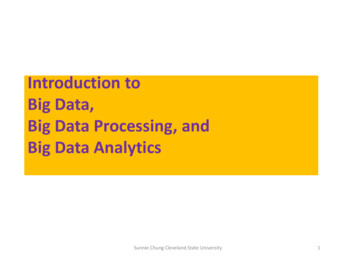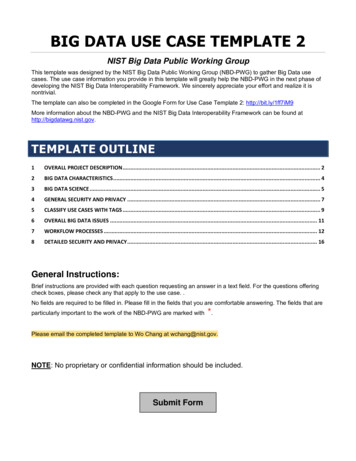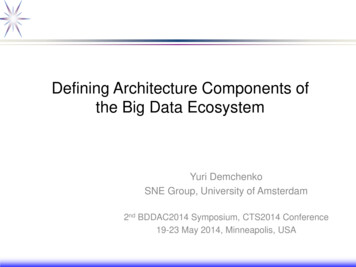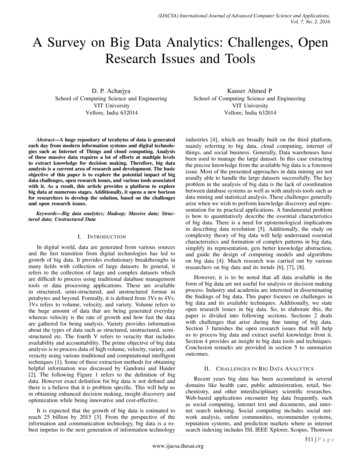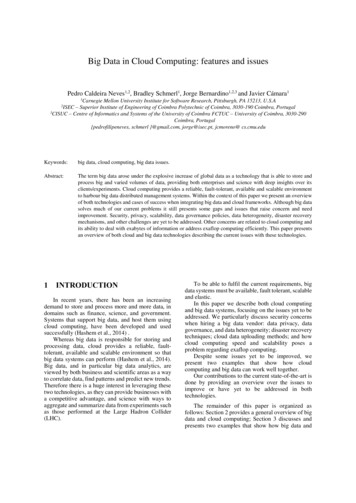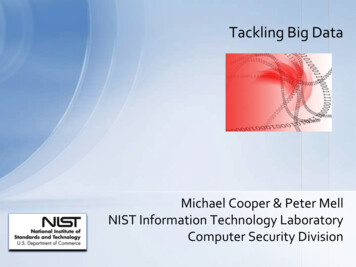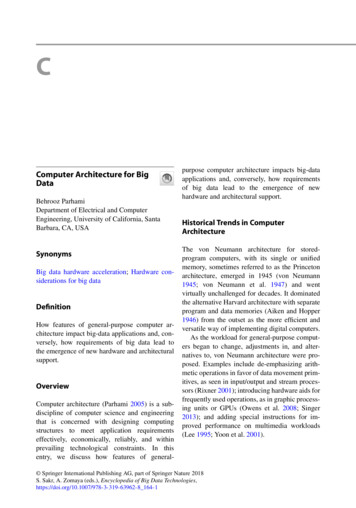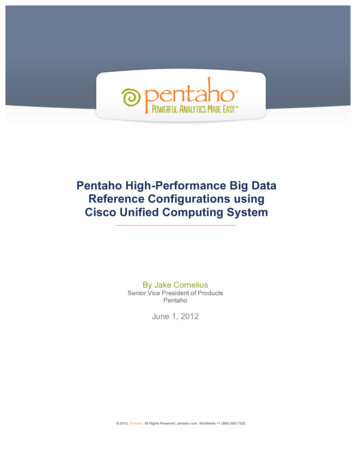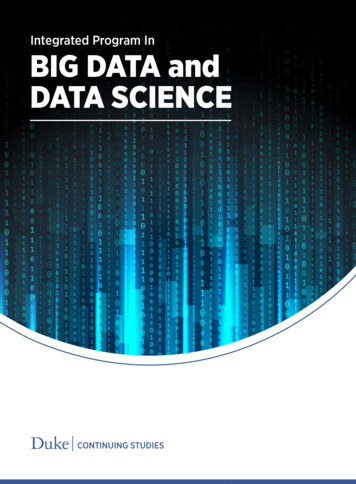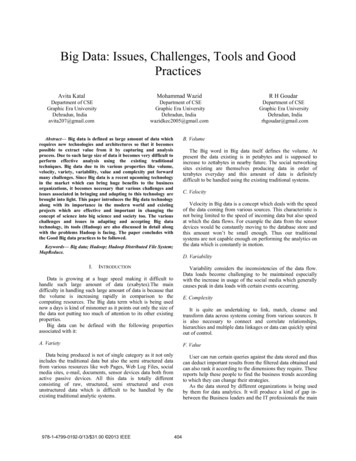
Transcription
Big Data: Issues, Challenges, Tools and GoodPracticesAvita KatalMohammad WazidR H GoudarDepartment of CSEGraphic Era UniversityDehradun, Indiaavita207@gmail.comDepartment of CSEGraphic Era UniversityDehradun, Indiawazidkec2005@gmail.comDepartment of CSEGraphic Era UniversityDehradun, Indiarhgoudar@gmail.comB. VolumeAbstract— Big data is defined as large amount of data whichrequires new technologies and architectures so that it becomespossible to extract value from it by capturing and analysisprocess. Due to such large size of data it becomes very difficult toperform effective analysis using the existing traditionaltechniques. Big data due to its various properties like volume,velocity, variety, variability, value and complexity put forwardmany challenges. Since Big data is a recent upcoming technologyin the market which can bring huge benefits to the businessorganizations, it becomes necessary that various challenges andissues associated in bringing and adapting to this technology arebrought into light. This paper introduces the Big data technologyalong with its importance in the modern world and existingprojects which are effective and important in changing theconcept of science into big science and society too. The variouschallenges and issues in adapting and accepting Big datatechnology, its tools (Hadoop) are also discussed in detail alongwith the problems Hadoop is facing. The paper concludes withthe Good Big data practices to be followed.The Big word in Big data itself defines the volume. Atpresent the data existing is in petabytes and is supposed toincrease to zettabytes in nearby future. The social networkingsites existing are themselves producing data in order ofterabytes everyday and this amount of data is definitelydifficult to be handled using the existing traditional systems.C. VelocityVelocity in Big data is a concept which deals with the speedof the data coming from various sources. This characteristic isnot being limited to the speed of incoming data but also speedat which the data flows. For example the data from the sensordevices would be constantly moving to the database store andthis amount won’t be small enough. Thus our traditionalsystems are not capable enough on performing the analytics onthe data which is constantly in motion.Keywords— Big data; Hadoop; Hadoop Distributed File System;MapReduce.I.D. VariabilityINTRODUCTIONVariability considers the inconsistencies of the data flow.Data loads become challenging to be maintained especiallywith the increase in usage of the social media which generallycauses peak in data loads with certain events occurring.Data is growing at a huge speed making it difficult tohandle such large amount of data (exabytes).The maindifficulty in handling such large amount of data is because thatthe volume is increasing rapidly in comparison to thecomputing resources. The Big data term which is being usednow a days is kind of misnomer as it points out only the size ofthe data not putting too much of attention to its other existingproperties.Big data can be defined with the following propertiesassociated with it:E. ComplexityIt is quite an undertaking to link, match, cleanse andtransform data across systems coming from various sources. Itis also necessary to connect and correlate relationships,hierarchies and multiple data linkages or data can quickly spiralout of control.A. VarietyF. ValueData being produced is not of single category as it not onlyincludes the traditional data but also the semi structured datafrom various resources like web Pages, Web Log Files, socialmedia sites, e-mail, documents, sensor devices data both fromactive passive devices. All this data is totally differentconsisting of raw, structured, semi structured and evenunstructured data which is difficult to be handled by theexisting traditional analytic systems.User can run certain queries against the data stored and thuscan deduct important results from the filtered data obtained andcan also rank it according to the dimensions they require. Thesereports help these people to find the business trends accordingto which they can change their strategies.As the data stored by different organizations is being usedby them for data analytics. It will produce a kind of gap inbetween the Business leaders and the IT professionals the main978-1-4799-0192-0/13/ 31.00 2013 IEEE404
concern of business leaders would be to just adding value totheir business and getting more and more profit unlike the ITleaders who would have to concern with the technicalities ofthe storage and processing. Thus the main challenges that existfor the IT Professionals in handling Big data are:x The designing of such systems which would be able tohandle such large amount of data efficiently andeffectively.x The second challenge is to filter the most important datafrom all the data collected by the organization. In otherwords we can say adding value to the business.III.IMPORTANCE OF BIG DATA AND VARIOUSPROJECTSBig data is different from the data being stored in traditionalwarehouses. The data stored there first needs to be cleansed,documented and even trusted. Moreover it should fit the basicstructure of that warehouse to be stored but this is not the casewith Big data it not only handles the data being stored intraditional warehouses but also the data not suitable to bestored in those warehouses. Thus there comes the point ofaccess to mountains of data and better business strategies anddecisions as analysis of more data is always better.In this paper we have presented the main issues andchallenges along with the complete description of thetechnologies/methods being employed for tackling the storageand processing problems associated with Big Data. The paperconcludes with the good Big data practices to be followed.A. Log Storage in IT IndustriesIT industries store large amount of data as Logs to dealwith the problems which seem to be occurring rarely in order tosolve them. But the storage of this data is done for few weeksor so though these logs need to be stored for longer durationbecause of their value. The Traditional Systems are not able tohandle these logs because of their volume, raw and semistructured nature. Moreover these logs go on changing with thes/w and H/w updates occurring. Big data analytics not onlydoes analysis on the whole /large data available to pinpoint thepoint of failures but also would increase the longevity of thelog storage.II. RELATED WORKIn paper [1] the issues and challenges in Big data arediscussed as the authors begin a collaborative researchprogram into methodologies for Big data analysis and design.In paper [2] the author discusses about the traditionaldatabases and the databases required with Big data concludingthat the databases don’t solve all aspects of the Big dataproblem and the machine learning algorithms need to be morerobust and easier for unsophisticated users to apply. There isthe need to develop a data management ecosystem aroundthese algorithms so that users can manage and evolve theirdata, enforce consistency properties over it and browse,visualize and understand their algorithm results. In paper [3]architectural considerations for Big data are discussedconcluding that despite the different architectures and designdecisions, the analytics systems aim for Scale-out, Elasticityand High availability. In paper [4] all the concepts of Big dataalong with the available market solutions used to handle andexplore the unstructured large data are discussed. Theobservations and the results showed that analytics has becomean important part for adding value for the social business. Thispaper [5] proposes the Scientific Data Infrastructure (SDI)generic architecture model. This model provides a basis forbuilding interoperable data with the help of available moderntechnologies and the best practices. The authors have shownthat the models proposed can be easily implemented with theuse of cloud based infrastructure services provisioning model.In paper [6] the author investigates the difference in Big dataapplications and how they are different from the traditionalmethods of analytics existing from a long time. In paper [7]authors have done analysis on Flickr, Locr, Facebook andGoogle social media sites. Based on this analysis they havediscussed the privacy implications and also geo-tagged socialmedia; an emerging trend in social media sites. The proposedconcept in this paper helps users to get informed about thedata relevant to them in such large social Big data.B. Sensor DataMassive amount of sensor data is also a big challenge forBig data. All the industries at present dealing with this largeamount of data make use of small portion of it for analysisbecause of the lack of the storage infrastructure and theanalysis techniques. Moreover sensor data is characterized byboth data in motion and data at rest. Thus safety, profit andefficiency all require large amount of data to be analyzed forbetter business insights.C. Risk AnalysisIt becomes important for financial institutions to model datain order to calculate the risk so that it falls under theiracceptable thresholds. A lot amount of data is potentiallyunderutilized and should be integrated within the model todetermine the risk patterns more accurately.D. Social MediaThe most use of Big data is for the social media andcustomer sentiments. Keeping an eye on what the customersare saying about their products helps business organizations toget a kind of customer feedback. This feedback is then used tomodify decisions and get more value out of their business.TABLE I.DomainBig Science405VARIOUS BIG DATA PROJECTSDescription1. The Large Hadron Collider (LHC) is the world's largestand highest-energy particle accelerator with the aim ofallowing physicists to test the predictions of different
B. Data Access and Sharing of Informationtheories of particle physics and high-energy physics. Thedata flow in experiments consists of 25 petabytes (as of2012) before replication and reaches upto 200 petabytesafter replication.2. The Sloan Digital Sky Survey is a multi-filter imagingand spectroscopic redshift survey using a 2.5-m wide-angleoptical telescope at Apache Point Observatory in NewMexico, United States. It is Continuing at a rate of about200 GB per night and has more than 140 terabytes ofinformation.1. The Obama administration project is a big initiativewhere a Government is trying to find the uses of the bigdata which eases their tasks somehow and thus reducingthe problems faced. It includes 84 different Big dataprograms which are a part of 6 different departments.2. The Community Comprehensive National CyberSecurity initiated a data center, Utah Data Center (UnitedStates NSA and Director of National Intelligence initiative)which stores data in scale of yottabytes. Its main task is toprovide cyber security.1. Amazon.com handles millions of back-end operationsevery day, as well as queries from more than half a millionthird-party sellers. The core technology that keeps Amazonrunning is Linux-based and as of 2005 they had theworld’s three largest Linux databases, with capacities of7.8 TB, 18.5 TB, and 24.7 TB.2. Walmart is estimated to store about more than 2.5petabytes of data in order to handle about more than 1million customer transactions every hour.3.FICO Falcon Credit Card Fraud Detection Systemprotects 2.1 billion active accounts world-wide.Information and Communication Technologies forDevelopment (ICT4D) uses the Information mic development, human rights andinternational development. Big data can make importantcontributions to international development.If data is to be used to make accurate decisions in time itbecomes necessary that it should be available in accurate,complete and timely manner. This makes the Datamanagement and governance process bit complex adding thenecessity to make Data open and make it available togovernment agencies in standardized mannerwithstandardized APIs, metadata and formats thus leading to betterdecision making, business intelligence and productivityimprovements.Expecting sharing of data between companies is awkwardbecause of the need to get an edge in business. Sharing dataabout their clients and operations threatens the culture ofsecrecy and competitiveness.C. Storage and Processing IssuesThe storage available is not enough for storing the largeamount of data which is being produced by almost everything:Social Media sites are themselves a great contributor alongwith the sensor devices etc.Because of the rigorous demands of the Big data onnetworks, storage and servers outsourcing the data to cloudmay seem an option. Uploading this large amount of data incloud doesn’t solve the problem. Since Big data insightsrequire getting all the data collected and then linking it in away to extract important information. Terabytes of data willtake large amount of time to get uploaded in cloud andmoreover this data is changing so rapidly which will make thisdata hard to be uploaded in real time. At the same time, thecloud's distributed nature is also problematic for Big dataanalysis. Thus the cloud issues with Big Data can becategorized into Capacity and Performance issues.The transportation of data from storage point to processingpoint can be avoided in two ways. One is to process in thestorage place only and results can be transferred or transportonly that data to computation which is important. But boththese methods would require integrity and provenance of datato be maintained.Processing of such large amount of data also takes largeamount of time. To find suitable elements whole of data Setneeds to be Scanned which is somewhat not possible .ThusBuilding up indexes right in the beginning while collectingand storing the data is a good practice and reduces processingtime considerably.BIG DATA CHALLENGES AND ISSUESA. Privacy and SecurityIt is the most important issue with Big data which issensitive and includes conceptual, technical as well as legalsignificance.x The personal information of a person when combinedwith external large data sets leads to the inference of newfacts about that person and it’s possible that these kinds offacts about the person are secretive and the person mightnot want the Data Owner to know or any person to knowabout them.x Information regarding the users (people) is collected andused in order to add value to the business of theorganization. This is done by creating insights in theirlives which they are unaware of.x Another important consequence arising would be Socialstratification where a literate person would be takingadvantages of the Big data predictive analysis and on theother hand underprivileged will be easily identified andtreated worse.x Big Data used by law enforcement will increase thechances of certain tagged people to suffer from adverseconsequences without the ability to fight back or evenhaving knowledge that they are being discriminated.D. Analytical challengesThe main challenging questions are as:xxxxx406What if data volume gets so large and varied and it is notknown how to deal with it?Does all data need to be stored?Does all data need to be analyzed?How to find out which data points are really important?How can the data be used to best advantage?
techniques which were used to do parallel data processingacross data nodes aren’t capable of handling intra-nodeparallelism. This is because of the fact that many morehardware resources such as cache and processor memorychannels are shared across a core in a single node.The scalability issue of Big data has lead towards cloudcomputing, which now aggregates multiple disparateworkloads with varying performance goals into very largeclusters. This requires a high level of sharing of resourceswhich is expensive and also brings with it various challengeslike how to run and execute various jobs so that we can meetthe goal of each workload cost effectively. It also requiresdealing with the system failures in an efficient manner whichoccurs more frequently if operating on large clusters. Thesefactors combined put the concern on how to express theprograms, even complex machine learning tasks.There has been a huge shift in the technologies being used.Hard Disk Drives (HDD) are being replaced by the solid stateDrives and Phase Change technology which are not having thesame performance between sequential and random datatransfer. Thus what kind of storage devices are to be used isagain a big question for data storage.Big data brings along with it some huge analytical challenges.The type of analysis to be done on this huge amount of datawhich can be unstructured, semi structured or structuredrequires a large number of advance skills. Moreover the typeof analysis which is needed to be done on the data dependshighly on the results to be obtained i.e. decision making. Thiscan be done by using one using two techniques: eitherincorporate massive data volumes in analysis or determineupfront which Big data is relevant.E. Skill RequirementSince Big data is at its youth and an emerging technologyso it needs to attract organizations and youth with diverse newskill sets. These skills should not be limited to technical onesbut also should extend to research, analytical, interpretive andcreative ones. These skills need to be developed in individualshence requires training programs to be held by theorganizations. Moreover the Universities need to introducecurriculum on Big data to produce skilled employees in thisexpertise.F. Technical Challenges3) Quality of Data: Collection of huge amount of data and itsstorage comes at a cost. More data if used for decision makingor for predictive analysis in business will definitely lead tobetter results. Business Leaders will always want more andmore data storage whereas the IT Leaders will take alltechnical aspects in mind before storing all the data. Big databasically focuses on quality data storage rather than havingvery large irrelevant data so that better results and conclusionscan be drawn.This further leads to various questions like how it can beensured that which data is relevant, how much data would beenough for decision making and whether the stored data isaccurate or not to draw conclusions from it etc.1) Fault Tolerance: With the incoming of new technologieslike Cloud computing and Big data it is always intended thatwhenever the failure occurs the damage done should be withinacceptable threshold rather than beginning the whole task fromthe scratch. Fault-tolerant computing is extremely hard,involving intricate algorithms. It is simply not possible todevise absolutely foolproof, 100% reliable fault tolerantmachines or software. Thus the main task is to reduce theprobability of failure to an "acceptable" level. Unfortunately,the more we strive to reduce this probability, the higher thecost.Two methods which seem to increase the fault tolerance in Bigdata are as: First is to divide the whole computation beingdone into tasks and assign these tasks to different nodes forcomputation. One node is assigned the work of observing thatthese nodes are working properly. If something happens thatparticular task is restarted.But sometimes it’s quite possible that that the wholecomputation can’t be divided into such independent tasks.There could be some tasks which might be recursive in natureand the input of the previous task is the input to the nextcomputation. Thus restarting the whole computation becomescumbersome process. This can be avoided by applyingCheckpoints which keeps the state of the system at certainintervals of the time. In case of any failure, the computationcan restart from last checkpoint maintained.4) Heterogeneous Data: Unstructured data represents almostevery kind of data being produced like social mediainteractions, to recorded meetings, to handling of PDFdocuments, fax transfers, to emails and more. Structured datais always organized into highly mechanized and manageableway. It shows well integration with database but unstructureddata is completely raw and unorganized. Working withunstructured data is cumbersome and of course costly too.Converting all this unstructured data into structured one is alsonot feasible.Structured data is the one which is organized in a way sothat it can be managed easily. Digging through unstructureddata is cumbersome and costly.V.2) Scalability: The processor technology has changed inrecent years. The clock speeds have largely stalled andprocessors are being built with more number of cores instead.Previously data processing systems had to worry aboutparallelism across nodes in a cluster but now the concern hasshifted to parallelism within a single node. In past theTOOLS AND TECHNIQUES AVAILABLEThe following tools and techniques are available:A. Hadoop407
These are areas where HDFS is not a good fit: Low-latencydata access, Lots of small file, multiple writers and arbitraryfile modifications.Hadoop is an open source project hosted by ApacheSoftware Foundation. It consists of many small sub projectswhich belong to the category of infrastructure for distributedcomputing. Hadoop mainly consists of :x File System (The Hadoop File System)x Programming Paradigm (Map Reduce)The other subprojects provide complementary services orthey are building on the core to add higher-level abstractions.There exist many problems in dealing with storage of largeamount of data.Though the storage capacities of the drives have increasedmassively but the rate of reading data from them hasn’t shownthat considerable improvement. The reading process takeslarge amount of time and the process of writing is also slower.This time can be reduced by reading from multiple disks atonce. Only using one hundredth of a disk may seem wasteful.But if there are one hundred datasets, each of which is oneterabyte and providing shared access to them is also a solution.There occur many problems also with using many pieces ofhardware as it increases the chances of failure. This can beavoided by Replication i.e. creating redundant copies of thesame data at different devices so that in case of failure thecopy of the data is available.The main problem is of combining the data being read fromdifferent devices. Many a methods are available in distributedcomputing to handle this problem but still it is quitechallenging. All the problems discussed are easily handled byHadoop. The problem of failure is handled by the HadoopDistributed File System and problem of combining data ishandled by Map reduce programming Paradigm. Map Reducebasically reduces the problem of disk reads and writes byproviding a programming model dealing in computation withkeys and values.Hadoop thus provides: a reliable shared storage andanalysis system. The storage is provided by HDFS andanalysis by MapReduce.2) MapReduce: MapReduce is the programming paradigmallowing massive scalability. The MapReduce basicallyperforms two different tasks i.e. Map Task and Reduce Task.A map-reduce computation executes as follows:Map tasks are given input from distributed file system. Themap tasks produce a sequence of key-value pairs from theinput and this is done according to the code written for mapfunction. These value generated are collected by mastercontroller and are sorted by key and divided among reducetasks. The sorting basically assures that the same key valuesends with the same reduce tasks. The Reduce tasks combineall the values associated with a key working with one key at atime. Again the combination process depends on the codewritten for reduce job.The Master controller process and some number of workerprocesses at different compute nodes are forked by the user.Worker handles map tasks (MAP WORKER) and reduce tasks(REDUCE WORKER) but not both.The Master controller creates some number of map andreduce tasks which is usually decided by the user program.The tasks are assigned to the worker nodes by the mastercontroller. Track of the status of each Map and Reduce task(idle, executing at a particular Worker or completed) is keptby the Master Process. On the completion of the workassigned the worker process reports to the master and masterreassigns it with some task.The failure of a compute node is detected by the master asit periodically pings the worker nodes. All the Map tasksassigned to that node are restarted even if it had completed andthis is due to the fact that the results of that computation wouldbe available on that node only for the reduce tasks. The statusof each of these Map tasks is set to idle by Master. These getscheduled by Master on a Worker only when one becomesavailable. The Master must also inform each Reduce task thatthe location of its input from that Map task has changed.B. Hadoop Components in detail1) Hadoop Distributed File System: Hadoop comes with adistributed File System called HDFS, which stands forHadoop Distributed File System. HDFS is a File Systemdesigned for storing very large files with streaming data accesspatterns, running on clusters on commodity hardware. HDFSblock size is much larger than that of normal file system i.e. 64MB by default. The reason for this large size of blocks is toreduce the number of disk seeks.A HDFS cluster has two types of nodes i.e. namenode (themaster) and number of datanodes (workers). The name nodemanages the file system namespace, maintains the file systemtree and the metadata for all the files and directories in thetree. The datanode stores and retrieve blocks as per theinstructions of clients or the namenode. The data retrieved isreported back to the namenode with lists of blocks that theyare storing. Without the namenode it is not possible to accessthe file. So it becomes very important to make namenoderesilient to failure.C. Comparison of Hadoop Technique with other systemTechniques1) Comparison with HPC and Grid Computing Tools: Theapproach in HPC and Grid computing includes the distributionof work across a cluster and they are having a common sharedFile system hosted by SAN. The jobs here are mainly computeintensive and thus it suits well to them unlike as in case of Bigdata where access to larger volume of data as networkbandwidth is the main bottleneck and the compute nodes startbecoming idle. Map Reduce component of Hadoop here playsan important role by making use of the Data Locality propertywhere it collocates the data with the compute node itself sothat the data access is fast.HPC and Grid Computing basically make use of the API’ssuch as message passing Interface (MPI). Though it providesgreat control to the user, the user needs to control the408
mechanism for handling the data flow. On the other hand MapReduce operates only at the higher level where the data flow isimplicit and the programmer just thinks in terms of key andvalue pairs. Coordination of the jobs on large distributedsystems is always challenging. Map Reduce handles thisproblem easily as it is based on shared-nothing architecture i.e.the tasks are independent of each other. The implementation ofMap Reduce itself detects the failed tasks and reschedulesthem on healthy machines. Thus the order in which the tasksrun hardly matters from programmer’s point of view. But incase of MPI, an explicit management of check pointing andrecovery system needs to be done by the program. This givesmore control to the programmer but makes them more difficultto write.xxxx2) Comparison with Volunteer Computing Technique: InVolunteer computing work is broken down into chunks calledwork units which are sent on computers across the world to beanalyzed. After the completion of the analysis the results aresent back to the server and the client is assigned with anotherwork unit. In order to assure accuracy, each work unit is sentto three different machines and the result is accepted if atleasttwo of them match. This concept of Volunteer Computingmakes it look like MapReduce. But there exists a bigdifference between the two the tasks in case of VolunteerComputing are basically CPU intensive. This tasks makesthese tasks suited to be distributed across computers astransfer of work unit time is less than the time required for thecomputation whereas in case of MapReduce is designed torun jobs that last minutes or hours on trusted, dedicatedhardware running in a single data center with very highaggregate bandwidth interconnects.xVII.xxxxCONCLUSIONThis paper described the new concept of Big data, itsimportance and the existing projects. To accept and adapt tothis new technology many challenges and issues exist whichneed to be brought up right in the beginning before it is toolate. All those issues and challenges have been described inthis paper. These challenges and issues will help the businessorganizations which are moving towards this technology forincreasing the value of the business to consider them right inthe beginning and to find the ways to counter them. Hadooptool for Big data is described in detail focusing on the areaswhere it needs to be improved so that in future Big data canhave technology as well as skills to work with.3) Comparison with RDBMS: The traditional database dealswith data size in range of Gigabytes as compared toMapReduce dealing in petabytes. The Scaling in case ofMapReduce is linear as compared to that of traditionaldatabase. In fact the RDBMS differs structurally, in updating,and access techniques from MapReduce.VI.Analyzing data sets including identifying informationabout individuals or organizations privacy is an issuewhose importance particularly to consumers is growing asthe value of Big data becomes more apparent.Data quality needs to be better. Different tasks likefiltering, cleansing, pruning, conforming, matching,joining, and diagnosing should be applied at the earliesttouch points possible.There should be certain limits on the scalability of thedata stored.Business leaders and IT leaders should work together toyield more bu
Big Data: Issues, Challenges, Tools and Good . generic architecture model. This model provides a basis for building interoperable data with the help of available modern technologies and the best practices. The authors have shown th
